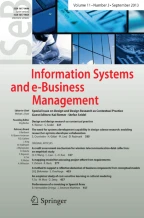Abstract
Artificial intelligence seems to be all pervasive and slowly has become an integral part of commercial entities. However, there needs to be an approach that can integrate human and machine interaction and make it a sustainable implementation. Using framework developed by Mohapatra (2019), we find that such parameters that can improve physical interactions with humans and domain processes. This article is an attempt to characterise these challenges and to exhibit a set of key decisional issues that need to be addressed for a cognitive robot to successfully share space and tasks with a human in retial services in a banking domain (Yang et al. in Inf Syst e-Bus Manag 17(1):1–25, 2019). Here, we identify first the needed individual and collaborative cognitive skills from the published framework and then apply them to a case study in retail banking domain. The article discusses each of these abilities, presents working implementations, and shows how they combine in a coherent and original deliberative architecture for human–robot interaction, which can be used for servicing customers (Tobias and Sebastian in Inf Syst e-Bus Manag 16(3):493–546, 2018). Supported by experimental results, we eventually show how explicit knowledge management, both symbolic and geometric, proves to be instrumental to richer and more natural human–robot interactions by pushing for pervasive, human-level semantics within the robot’s deliberative system.
Source: Authors
Similar content being viewed by others
References
Abidoye RB, Chan E (2016) Achieving property valuation accuracy in developing countries: the implication of data source. Int J Hous Markets Anal 13(3):37–72
Beetz MS, Lemaignan R, Ros L, Mösenlechner R, Alami M (2010) ORO, a knowledge management platform for cognitive architectures in robotics. In: IEEE/RSJ international conference on intelligent robots and systems
Ge XJ, Runeson G (2004) Modeling property prices using neural network model for Hong Kong. Int Real Estate Rev 7(1):121–138
Mora-Esperanza JG (2004) Artificial intelligence applied to real estate valuation. An example for the appraisal of Madrid. In: Proceedings of CATASTRO, 2004
McDowell M (2019) Analytics are reshaping fashion’s old-school instincts. Retrieved December 1, 2019, from https://www.voguebusiness.com/technology/data-trend-forecasting-google-tracking-tools
Mohapatra S (2015) Using integrated information system for patient benefits: a case study in India. Int J Healthc Manag 8(4):262–271
Mohapatra S (2017) An empirical study for finding factors that would optimise productivity and quality in IT business. Int J Prod Qual Manag 20(2):169–196
Mohapatra S (2019) Critical review of literature and development of a framework for application of artificial intelligence in business. Int J Enterp Netw Manag 10(2):176–185. https://doi.org/10.1504/IJENM.2019.100546
Mohapatra S, Mohanty R (2017a) Adopting MOOCs for afforable quality education. Educ Inf Technol 22(5):2027–2053
Mohapatra S, Mohanty S (2017b) Assessing the overall value of an online writing community. Educ Inf Technol 22(3):985–1003
Mohapatra S, Mohanty S (2017c) Improving operational efficiency in utility sector through technology intervention. Int J Enterp Netw Manag 8(4):291–326
Mohapatra S, Mohanty R (2018) Making online courses free for everyone: an empirical study to determine the feasibility. Int J Bus Innov Res 15(4):403–430
Mohapatra S, Murarka S (2016) Improving patient care in hospital in India by monitoring influential parameters. Int J Healthc Manag 9(2):83–101
Mohapatra S, Patra D (2017) User acceptance of web-based talent assessment platform (TAP). Int J Bus Excell 12(4):450–468
Mohapatra S, Roy R (2012) Moving to products: entrepreneurial IT firms in India. Int J Project Organ Manag 4(1):86–97
Mohapatra S, Sahu K (2018) Empirical research on the adoption and diffusion of e-commerce portals. Int J Bus Innov Res 15(2):137–151
Mohapatra S, Sabharwal L, Sabharwal A (2013) Bridge: the missing link. Asian Case Res J 17(1):181–198
Mohapatra S, Choudhury A, Ganesh K (2017) Framework for supporting business process reengineering’-based business models. Int J Bus Innov Res 13(4):451–474
Mooya MM (2015) The education and professional practice of valuers in South Africa: a critical review. Property Manag 33(3):245–274
Sarkar S, Mohapatra S, Sundarakrishnan J (2017) Assessing impact of technology based digital equalizer programme on improving student learning outcomes. Educ Inf Technol 22(1):195–213
Standish J, Ganapathy V (2018) Think tank: how AI can power the future of fashion. WWD. https://wwd.com/business-news/business-features/jill-standish-think-tank-1202941433/. Accessed 6 Dec 2019
The Economist (2017) Can data predict fashion trends? (2017). Retrieved 1 Dec 2019. https://www.economist.com/business/2017/07/27/can-data-predict-fashion-trends
Yalpir S (2014) Forecasting residential real estate values with AHP method and integrated GIS. In: Conference proceedings of people, buildings and environment 2014, an international scientific conference, Kroměříž, Czech Republic, pp 694–706
Yazan B (2015) Three approaches to case study methods in education: yin, merriam, and stake. Qual Rep 20(2):134–152
Author information
Authors and Affiliations
Corresponding author
Additional information
Publisher's Note
Springer Nature remains neutral with regard to jurisdictional claims in published maps and institutional affiliations.
Rights and permissions
About this article
Cite this article
Mohapatra, S. Human and computer interaction in information system design for managing business. Inf Syst E-Bus Manage 19, 1–11 (2021). https://doi.org/10.1007/s10257-020-00475-3
Received:
Revised:
Accepted:
Published:
Issue Date:
DOI: https://doi.org/10.1007/s10257-020-00475-3
